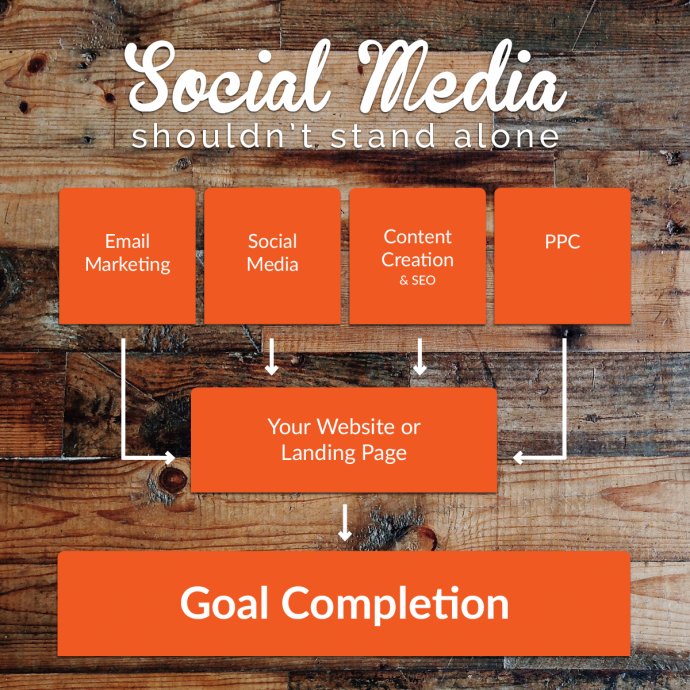When clients come to us and express their want and need for a social presence we are ecstatic however, we do ask them what their goals are and give a forewarning. For companies who are interested in diving into social media there is a lot to consider. Creating a social media presence for your company can be a valuable asset, but it can also be time consuming and confusing if you’re not using a trusted advisor or you’re not all that socially savvy yourself.
Social media for businesses should not and simply can not stand alone. While social media is an integral piece of the marketing mix, unless you have other pillars of digital marketing (i.e. writing blogs, email marketing campaigns, other ways to drive traffic to your social media channels) to support it, don’t expect much of a ROI from social media. Additionally, especially for B2B companies, solely having viewers across your social channels may not mean much of anything beyond brand awareness, which is important, but again, don’t expect a surge of interested clients from little effort!
If you want something you can measure, the end goal must be to get users back to your website (or landing page) to complete an action (i.e. sign up for an email list, give an email address in order to receive an e-book, fill out a contact form). Some people view social media for business as fluff. If done correctly, social media can be a strong ROI. When your marketing and sales efforts are aligned, social media can be the element that enriches your brand and pushes you ahead of your competition. If you spend the right amount of time and energy creating a great plan and carrying out social media campaigns that convert, it could become your brand’s greatest asset!
Content Marketing and SEO
When beginning to use social media for business, the first steps should be creating a content creation strategy followed by beginning to create content. Whether it’s blog writing for SEO, guest blogging on sites that your audience visits or creating infographics that will be featured within an industry publication, content strategy and creation should be the first steps.
In addition to having something to share across your social channels, content creation is also beneficial for SEO purposes. If Google sees that you are actively adding pages to your site and users are finding the content on these pages useful and relevant, your site will gain recognition as being a good answer to queries users are searching for. While creating great content is definitely not all that goes into SEO and fixing any errors, speed problems, etc, should be a SEO priority, content creation is still beneficial and can snowball if you’re doing it correctly.
Social Media
What Do I Post?
Social Media is usually seen as an all encompassing term but it’s really just a piece of the marketing mix–a piece that brings everything that your brand creates in front of your audience. If you see a brand posting graphics on a social media channel they have implemented a content creation strategy by doing research to find out what their audience responds to the best. After concluding that a certain set of graphics were the right fit, they are posted across the brand’s social channels. Posting on social media is a step in a company’s marketing strategy.
Who Do I Interact With?
In addition to deciding what exactly a brand should post on social media, there is also the strategy behind which users to follow and interact with. A best practice is to follow people within your audience, people who are interested in the types of content you’ll be posting and even competitors. One great way to strategize who to engage with on social media is to go after your industry influencers. Also, if your brand is location specific, for example, if your company is strictly baltimore based, follow and interact with a lot of Baltimore based users that meet your criteria.
When you create a strategy for which users to follow and interact with, eventually your profile, specifically on Twitter, will show up under the “Who to Follow” section. Because we post a lot about branding, marketing and social media, users who are interested in those topics will often see our profile in this section.

Additionally, when users who are interested in our content share our links their followers will see our content as well.
Email Marketing
Did you know that 44% of email recipients made at least one purchase last year based on a promotional email? Studies show that email marketing still has an incredible ROI. In comparison to paid ads, the cost to reach your email list of leads who are actually interested in your content is significantly cheaper. According to a study by The Earnest Agency, 72% of B2B buyers are most likely to share useful content via email. What are you waiting for? Adding email marketing to your marketing mix could be your lowest cost option for reaching current and new audience members and converting them into leads!
PPC
Whether you’ve already acquired an engaged audience or you want to give your social media marketing efforts a push, buying paid ads on social media allows your brand to grow the amount of people you are reaching. By taking a great piece of content and putting it in front of current or new audience members you can acquire new leads that may be interested in the types of content you’re producing. Eventually, these interested audience members may be converted into leads and then into clients! While you can still get great content in front of audience members without paid ads, spending on social can go a long way and can greatly jumpstart your efforts.
In addition to paid social media ads on Facebook, Twitter and Linkedin, which usually promote existing brand pieces like industry relevant articles, ebook and presentations, adding items like google adwords to your marketing mix can really target users who aren’t just browsing but are actively looking for your services. While PPC doesn’t always have to be included, if you’re looking for a quicker measurable ROI, PPC may be for you.

Conversions
One of the most valuable measurable items related to social media marketing is when a user completes a goal, also known as a conversion. If you set up a landing page with a free piece of content (e-book, presentation, etc) and the user gives their email in order to get it, that’s a conversion. If a user reads one of your blog articles and then heads over to your contact form and fills it out, that is also a conversion. A conversion is when a user completes any task you’ve set up for them to complete. Most conversions include gaining some valuable data from the user such as their email address, phone number or other piece of information where you can further contact them (nurture them) so that they will one day become your client.
Social Media is a Piece of the Puzzle
Social media alone is not your magic answer. Social media is a piece of your marketing mix and if done correctly, it can be a valuable piece with a large ROI. If attempted without a plan of action and without the other important pieces of the puzzle, your social media efforts may have no measurable ROI at all. If you’re about to dive into the world of social media for business, make sure you have a strategic plan and set specific goals for the best results.

